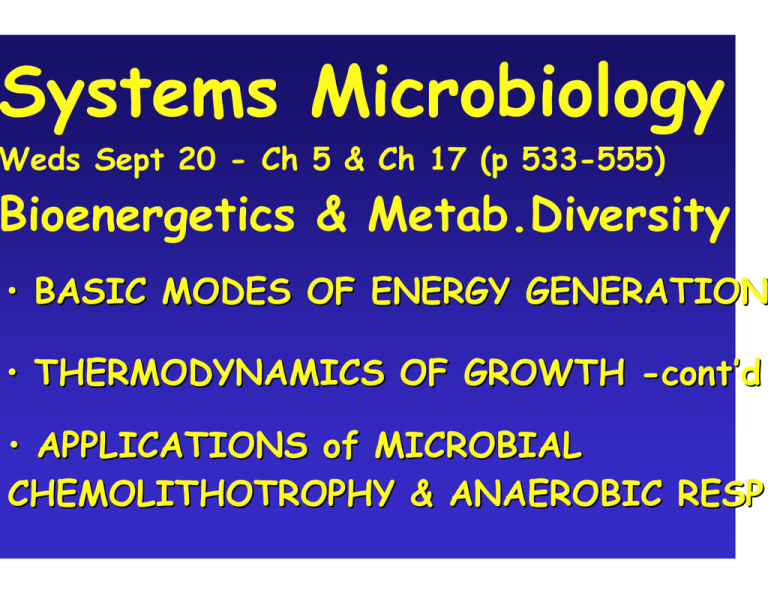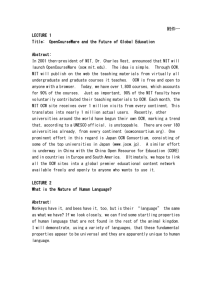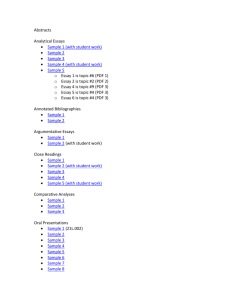Systems Microbiology Bioenergetics & Metab.Diversity
advertisement

Systems Microbiology Weds Sept 20 - Ch 5 & Ch 17 (p 533-555) Bioenergetics & Metab.Diversity • BASIC MODES OF ENERGY GENERATION • THERMODYNAMICS OF GROWTH -cont’d • APPLICATIONS of MICROBIAL CHEMOLITHOTROPHY & ANAEROBIC RESP. Phototrophs (Use Light as Energy Source ) Photoautotrophs (Use CO2) Photoheterotrophs (Use Organic Carbon) Figure by MIT OCW. Cyclic Photophosphorylation ATP Electron transport chain Excited electrons (2 e-) Light Chlorophyll Energy for production of ATP Electron carrier Figure by MIT OCW. Anoxygenic photoautotrophs utilize cyclic photophosphorylation LOTS OF DIVERSITY IN BACTERIAL ANOXYGENIC PHOTOTROPHS ! Purple Bacteria Green Sulfur Bacteria -1.25 -1.0 P840 P870 -0.75 E 0' (V) Chl a-OH Chl a BChl BPh -0.25 +0.5 P870 Cyt c2 Q Cyt bc1 Light Reverse electron P840 flow Fd Fd NADH +0.25 FeS FeS -0.5 0 Heliobacteria P798 Cyt c553 Cyt bc1 Light Cyt bc1 Q P798 Q Cyt c553 Light Figure by MIT OCW. P700* -1.25 Chl a0 -1.0 -0.75 QA P680* -0.5 Ph 0 +0.25 +0.5 Fp NAD(P)H Q pool Cyt bf Noncyclic electron flow (generates proton motive force) +0.75 e+1.0 Fd QB 0.0 (V) FeS NAD(P)+ QA -0.25 E' Cyclic electron flow (generates proton motive force) H2O P680 Photosystem II 1 O + 2H 2 2 Light Pc P700 Light Photosystem I The Z Scheme PSII PSI Figure by MIT OCW. HALOARCHAEA Live in hypersaline habitats Aerial photograph of haloarchaea changing the colors of their saltwater habitats removed due to copyright restrictions. H+ Asp-96 Asp-85 Retinal Arg-82 Glu-204 Glu-194 H+ Figure by MIT OCW. Microbial rhodopsins fall into two main functional classes Sensory rhodopsins Light-driven ion pumps Rhodopsin Functional Diversity H+ BR HR SRl SRll Htrl Htrll Cl- Cytoplasm Methylation helices Bacteriorhodpsin His-kinase Regulator His-kinase P Regulator P Regulator Flagellar motor Figure by MIT OCW. Bacteriorhodopsin and proteorhodospin Light driven proton pumps Cell interior H+ High H+ concentration 2 H+ Asp-96 Outside cell H+ } Electron transport chain (includes proton pumps) Asp-85 Retinal 1 Arg-82 Glu-204 ATP synthase 3 Glu-194 ADP+ Pi Electrons from NADH or chlorophyll H+ Cell exterior Inside cell Membrane ATP Low H+ concentration Figure by MIT OCW. Figure by MIT OCW. Images and diagrams of various rhodopsins removed due to copyright restrictions. See Science 289 (September 15, 2000). www.sciencemag.org. Venter et al., Environmental Genome Shotgun Sequencing of the Sargasso Sea, Science 394:66-74 (2004) Diagram removed due to copyright restrictions. Many new bacterial proteorhodopsins discovered in environmetnal shotgun sequencing Images of a hybrid automobile, hydrocarbons, and electricity removed due to copyright restrictions. Where do organisms get their energy? ALL ORGANISMS chemotrophs phototrophs Derive energy from light chemolithotrophs Oxidize inorganic compounds chemoorganotrophs Oxidize organic compounds Relative Voltage Relative Voltage REDUCTANTS (EAT) MICROBIAL METABOLIC DIVERSITY Microbes can eat & breathe just about anything ! OXIDANTS (BREATHE) -10 -10 Photoreductants -8 -6 -4 Organic Carbon H2 H2S So A -2 0 -8 Fe(II) B -6 CO2 SO4= AsO43FeOOH +2 +8 + 10 -2 0 +2 +4 +6 -4 NH4+ Mn(II) SeO3 NO2NO3MnO2 +4 +6 +8 + 10 + 12 NO3-/N2 + 12 + 14 O2 + 14 Diagrams removed due to copyright restrictions. See Figures 5-22a, 5-20, and 5-23 in Madigan, Michael, and John Martinko. Brock Biology of Microorganisms. 11th ed. Upper Saddle River, NJ: Pearson Prentice Hall, 2006. ISBN: 0131443291. METABOLIC DIVERSITY - Continued …. Chemolithoautotroph (chemo [chemical], litho [rock], auto[self], troph [feeding]) Energy source: inorganic substrates (H2, NH3, NO2-, H2S, Fe2+) Carbon source: CO2 e- acceptor: O2(aerobes), or S(some anaerobes), Fe3+, NO3, SO4 Chemolithoautotrophs can be grouped according to the inorganic compounds that they oxidize for energy: Nitrifiers - Oxidize reduced Nitrogen compounds such as NH4+ Sulfur Oxidizers- Oxidize reduced Sulfur compounds such as H2S, S0, and S2O- Iron Oxidizers- Oxidize reduced Iron-Fe2+ (ferrous iron) Hydrogen Oxidizers-Oxidize Hydrogen gas-H2 Table of energy yields from the oxidation of various inorganic electron donors removed due to copyright restrictions. See Table 17-1 in Madigan, Michael, and John Martinko. Brock Biology of Microorganisms. 11th ed. Upper Saddle River, NJ: Pearson Prentice Hall, 2006. ISBN: 0131443291. METABOLIC DIVERSITY CHEMOLITHOAUTOTROPHS - Examples CHEMOLITHOTROPHIC AMMONIA OXIDATION - AEROBIC NH4+ + 3/2O2 --> NO2- + H2O + 2H+ O N + 5H+ NH2OH + H2O O- Oxidation of hydroxylamine 4e- Cyt c 2eHAO Cyt c 2eAMO 2e- Q Periplasm 2H+ H+ 2eCyt aa3 1 O + 4H+ 2 2 NH2OH + H2O NH3 + O2+ 2H+ Oxidation of ammonia H2O Reduction of oxygen ADP ATP + Pi H+ Figure by MIT OCW. CHEMOLITHOTROPHIC AMMONIA OXIDATION ANAEROBIC Anammox means "anaerobic ammonium oxidation". Anammox is both a new low-cost method of N-removal in wastewater treatment, and a spectacular microbial way of life - woo - woo ! Courtesy of the Department of Microbiology at Radboud University Nijmegen. Used with permission. 2NH4+/N2 half reaction (6e-) Eo = -0.277 V 2NO2-/N2 half reaction (6e-) Eo = +0.956 V ΔEo= Eo (electron acceptor) - Eo (electron donor) = 1233 mV ΔGo=-nF ΔEo= -(3) (96.5 kJ/Vmol)(1.233V) = - 357 kJ/mol Broda predicted, based solely on the thermodynamics, that such microorganisms should exist. (And also the fact that if a bioenergetically favorable niche exists, a microbe will evolve to fill it !). About a decade later, the ’ bugs’ were discovered in bioreactors started from waste water treatment plants. Diagram removed due to copyright restrictions. Compared to conventional nitrification/denitrification, this method saves 100% of the carbon source, & 50% of the required oxygen. This leads to a reduction of operational costs of 90%, a decrease in CO2 emissions of more than 100% (the process actually consumes CO2), and a decrease in energy demand. Photograph removed due to copyright restrictions Anaerobic ammonium oxidation by anammox bacteria in the Black Sea Marcel M. M. Kuypers, A. Olav Sliekers, Gaute Lavik, Markus Schmid, Bo Barker Jørgensen, J. Gijs Kuenen, Jaap S. Sinninghe Damsté, Marc Strous and Mike S. M. Jetten. Nature 422, 608-611 (10 April 2003) Graphs removed due to copyright restrictions. ANAEROBIC RESPIRATION = Dumping your electrons on something other than oxygen Denitrification = Use of NO3- as terminal electron acceptor, that results in complete conversion to N2 gas. Diagrams removed due to copyright restrictions. See Figures 17-35 and 17-37 in Madigan, Michael, and John Martinko. Brock Biology of Microorganisms. 11th ed. Upper Saddle River, NJ: Pearson Prentice Hall, 2006. ISBN: 0131443291. Geobacter growing on iron oxides Anaerobic respiration CH3COO- Image of geobacter growing on iron oxides removed due to copyright restrictions. CO2 Fe3+ e- Fe2+ Complex Organic Matter Hydrolysis Fermentable Substrates Fermentation H2 Other low molecular weight organic acids Acetate } Microbial Competition for Substrates } NO3- reducers Mn(IV) reducers Fe(III) reducers SO42- reducers Methanogens Organic Matter Degradation In Anaerobic Environments Figure by MIT OCW. Diagram removed due to copyright restrictions. Energetic explains order: not all eacceptors are equal! E- acceptor ΔGo’ (using glucose) Oxygen -3190 kJ/mol NO3- -3030 Mn (IV) -3090 Fe(III) -1410 Sulfate -380 CO2 -350 From Nealson and Saffarini 1994 25 Complex Assemblage of Organic Matter Hydrolysis into Constituents Fermentable Sugars and Amino Acids Fermentation by a Fermentative Microbial Consortium Long-Chain Fatty Acid Acetate and Minor Products Aromatic Compounds Fe3+ Oxide Geobacter spp. Fe2+ CO2 Generalized pathway for the anaerobic oxidation of organic matter to carbon dioxide with Fe3+ oxide serving as an electron acceptor in temperate, freshwater and sedimentary environments. The process is mediated by a consortium of fermentative microorganisms and Geobacter species. Figure by MIT OCW. High organics Low O2 Source Methanogenic SO42 reduction Fe(III) reduction Mn(IV) reduction reduction NO 3 (IV) Groundwater flow Aerobic High O2 Figure by MIT OCW. The distribution of terminal electron-accepting processes (TEAPs) observed within anaerobic portions of aquifers contaminated with organic compounds. Images removed due to copyright restrictions. See Lovley, D. R., E. J. P. Phillips, Y. A. Gorby, and E. R. Landa. "Microbial Reduction of Uranium." Nature 350 (1991): 413-416. Anaerobic respiration to “clean up” of uranium pollution Soluble= mobile Insoluble, immobile Acetate + U (VI) U (IV)s + CO2 Photograph removed due to copyright restrictions. CH3C00- + 4 U(VI)U (IV)s + 2HCO3- + 9H+ Carried out by Geobacter Example of “bioremediation” Lovley DR, Phillips EJP, Gorby YA, Landa ER. Microbial Reduction of Uranium, 1991, Nature. 350(6317): 413-6. Diagram removed due to copyright restrictions. Diagram removed due to copyright restrictions. See Bond, Holmes, Tender, and Lovley. Science 295 (2002): 483-485. Diagram and photograph of a sediment microbial fuel cell removed due to copyright restrictions. V=IR Atomic force microscope stage Correspondence between pilus current and applied voltage demonstrating the linear, ohmic, response characteristic of a true conductor. Extracellular electron transfer via microbial nanowires. Schematic of the electronic connection of the AFM tip in a conducting probe atomic force microscope (CP-AFM). HOPG, highly oriented pyrolytic graphite. Nature. 2005 Jun 23;435(7045):1098-101. ‘Good’ electron acceptors ‘Good’ electron donors Photograph removed due to copyright restrictions Sulfate Reduction Zone SO42- Seawater Sea Floor SO42- Diffusion C DNS B A DNS METHANE FLUX Figure by MIT OCW. ANAEROBIC METHANE OXIDATION Geochemical Observations: CH4 + SO42- HCO3- + HS- + H2O Microbiologically ??? CH4 + 2H2O HSO4- + 4H2 CO2 + 4H2 “Reverse Methanogenesis” ΔGo’ = +131 kJ/mol HS- + 4H2O Sulfate reduction CH4 + HSO42- CO2 + HS- + 2H2O ΔGo’ = -156 kJ/mol ΔGo’ = -25 kJ/mol SO4 -2 CH4 H2 HS CO2 World maps showing global methane distribution removed due to copyright restrictions. See D’Hondt et al. Science 295 (2002): 2067.





